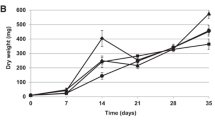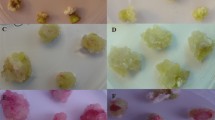Abstract
The fungus Leptosphaeria maculans that causes blackleg can attack winter rape throughout the entire growing season. Therefore, appropriate treatments were designed to simulate environmental factors that may occur under field conditions. The callus tissue of winter rape was treated with abiotic stress in the form of cold (2 °C) and temperature change (2/20 °C and 20/2 °C), and biotic stress in the form of secondary metabolites of L. maculans. The following parameters were analyzed: total phenolics, the activity of l-phenylalanine ammonia lyase (PAL), catalase, respiration intensity, heat emission, and metabolic activity determined by means of 2,3,5-triphenyl-tetrazolium chloride (TTC) assay. Additionally, the changes in the electrical potential, known as a sensitive indicator of biochemical changes in the callus tissue, were measured. The obtained results seem to indicate rather increased stress, caused by temperature (2 or 20 °C) or its changes (2/20 °C, 20/2 °C) and the secondary metabolites of L. maculans than a cross reaction. The factor that most strongly affected the metabolism of winter rape callus tissue was the temperature change, which masked the changes caused by the fungal secondary metabolites or intensified their adverse effects. The only parameters that could be regarded as reliable indicators of the callus tissue response to the elicitation with secondary metabolites of L. maculans were catalase activity and respiration intensity. Additionally, a protective function of low temperature involved a reduction in catalase activity, resulting in increased level of reactive oxygen species (ROS), key molecules inducing the defense mechanisms during pathogenesis. Only the changes in l-phenylalanine ammonia lyase (PAL) activity and the accompanying changes in the content of phenolic compounds can be considered as beneficial effects of low temperature (2 °C) on a more efficient callus acclimation to the biotic stress.






Similar content being viewed by others
References
Aebi H (1984) Catalase in vitro. Method Enzymol 105:121–126
Anekonda TS, Criddle RS, Libby WJ (1994) Calorimetric evidence for site-adapted biosynthetic metabolism in coast redwood. Can J Forest Res 24:380–389
Balesdent MH, Jędryczka M, Jain L, Mendes-Pereira E, Bertrandy J, Rouxel T (1998) Conidia, substrate for Internal Transcribed Spacer-based PCR identification of component of the Leptosphaeria maculans sp. Complex Phytopathol 88:12–17
Bradford M (1976) A rapid and sensitive method for the quantitation of microgram quantities of protein utilizing the principle of protein-dye binding. Anal Biochem 72:248–254
Cheong YH, Chang HS, Gupta R, Wang X, Zhu T, Luan S (2002) Transcriptional profiling reveals novel interactions between wounding, pathogen, abiotic stress, and hormonal responses in Arabidopsis. Plant Physiol 129:661–677
Criddle RS, Breidenbach RW, Rank DR, Hopkin MS, Hansen LD (1990) Simultaneous calorimetric and respirometric measurement of plants tissues. Termochim Acta 172:213–221
Criddle RS, Fontana AJ, Rank DR, Paige D, Hansen LD, Breidenbach RW (1991) Simultaneous measurement of metabolic heat rate, CO2 production, and O2 consumption by microcalorimetry. Anal Biochem 194:413–417
Dallaire S, Houde M, Gagne Y, Saini HS, Boileau S, Chevrier N, Sarhan F (1994) ABA and low temperature induce freezing tolerance via distinct regulatory pathways in wheat. Plant Cell Physiol 35:1–9
Ergon Å, Tronsmo AM (2006) Components of pink snow mould resistance in winter wheat are expressed prior to cold hardening and in detached leaves. J Phytopathol 154:134–142
Filek M, Kościelniak J (1997) The effect of wounding the roots by high temperature on the respiration rate of the shoot and propagation of electric signal in horse bean seedlings (Vicia faba L. minor). Plant Sci 123:39–46
Fromm J, Lautner S (2007) Electrical signals and their physiological significance in plants. Plant Cell Environ 30:249–257
Fujita M, Fujita Y, Noutoshi Y, Takahashi F, Narusaka Y, Yamaguchi-Shinozaki K, Shinozaki K (2006) Crosstalk between abiotic and biotic stress responses: a current view from the points of convergence in the stress signaling networks. Curr Opin Plant Biol 9:436–442
Galiba G, Tuberosa R, Kocsy G, Sutka J (1993) Involvement of chromosome 5A and chromosome 5D in cold-induced abscisic acid accumulation in and frost tolerance of wheat calli. Plant Breed 110:237–242
Gaudet DA, Laroche A, Yoshida M (1999) Low temperature-wheat-fungal interactions: a carbohydrate connection. Physiol Plant 106:437–444
Gaudet DA, Wang Y, Frick M, Puchalski B, Penniket C, Ouellet T, Robert L, Singh J, Laroche A (2011) Low temperature induced defence gene expression in winter wheat in relation to resistance to snow moulds and other wheat diseases. Plant Sci 180:99–110
Gołębiowska G, Wędzony M, Płażek A (2011) The responses of pro- and antioxidative systems to cold-hardening and pathogenesis differ in triticale (x Triticosecale Wittm.) seedlings susceptible or resistant to pink snow mould (Microdochium nivale Fr., Samuels & Hallett). J Phytopathol 159:19–27
Gugel RK, Petrie GA (1992) History, occurrence, impact, and control of blackleg of rapeseed. Can J Plant Pathol 14:36–45
Hura K (1999) Effect of Phoma lingam (Tode: Fr.) Desm. fungus secondary metabolites on callus tissue of winter rape. Advances of Agricultural Sciences Problem Issues 469:563–572 (abstract in English)
Hura K, Hura T, Bączek-Kwinta R, Grzesiak M, Płażek A (2014a) Induction of defense mechanisms in seedlings of oilseed winter rape inoculated with Phoma lingam (Leptosphaeria maculans). Phytoparasitica 42:145–154
Hura K, Hura T, Dziurka K, Dziurka M (2014b) Biochemical defense mechanisms induced in winter oilseed rape seedlings with different susceptibility to infection with Leptosphaeria maculans. Physiol Mol Plant Pathol 87:42–50
Hura K, Hura T, Grzesiak M (2014c) Function of the photosynthetic apparatus of oilseed winter rape under elicitation by Phoma lingam phytotoxins in relation to carotenoid and phenolic levels. Acta Physiol Plant 36:295–305
Ishihara A, Ohtsu Y, Iwamura H (1999) Biosynthesis of oat avenanthramide phytoalexins. Phytochemistry 50:237–242
Jędryczka M, Rouxel T, Balesdent MH, Mendes Pereira E, Bertrandy J (1997) Molecular characterization of Polish Phoma lingam isolates. Cereal Res Commun 25:279–283
Kachlicki P, Jedryczka M, Zhang W (2000) Secondary metabolites of Tox0 Phoma lingam strains and their phytotoxic activity. Integrated Control in Oilseed Crops. IOBC/WPRS Bull 23:21
Kacperska A (2004) Sensor types in signal transduction pathways in plant cells responding to abiotic stressors: do they depend on stress intensity? Physiol Plantarum 122:159–168
Kalina M, Palmer JM (1968) The reduction of tetrazolium salts by plant mitochondria. Histochemie 14:366–374
Larkin PJ, Scowcroft WR (1981) Somaclonal variation—a novel source of variability from cell cultures for plant improvement. Theor Appl Genet 60:197–214
Mittler R (2006) Abiotic stress, the field environment and stress combination. Trends Plant Sci 11:15–19
Murashige T, Skoog F (1962) A revised medium for rapid growth and bioassay with tobacco tissue culture. Physiol Plant 15:473–497
Peltonen S, Karjalainen R (1995) Phenylalanine ammonia-lyase activity in barley after infection with Bipolaris sorokiniana or treatment with its purified xylanase. J Phytopathol 143:239–245
Peltonen S, Mannonen L, Karjalainen R (1997) Elicitor-induced changes of phenylalanine ammonia-lyase activity in barley cell suspension cultures. Plant Cell Tissue Organ Cult 50:185–193
Płażek A, Rapacz M (2000) The intensity of respiration and heat emission from seedlings of Festuca pratensis (Hud.) and Hordeum vulgare L. during pathogenesis caused by Bipolaris sorokiniana (Sacc.) Shoem. Acta Physiol Plant 22:25–30
Płażek A, Żur I (2003) Cold-induced plant resistance to necrotrophic pathogens and antioxidant enzyme activities and cell membrane permeability. Plant Sci 164:1019–1028
Płażek A, Hura K, Rapacz M, Żur I (2001) The influence of ozone fumigation on metabolic efficiency and plant resistance to fungal pathogens. J Appl Bot Food Qual 75:8–13
Płażek A, Hura K, Żur I (2003a) Reaction of winter oilseed rape callus to different concentrations of elicitors: pectinase or chitosan. Acta Physiol Plant 25:83–89
Płażek A, Hura K, Żur I, Niemczyk E (2003b) Relationship between frost tolerance and cold-induced resistance of spring barley, meadow fescue and winter oilseed rape to fungal pathogens. J Agron Crop Sci 189:333–340
Płażek A, Hura K, Żur I (2005) Influence of chitosan, pectinase and fungal metabolites on activation of phenylpropanoid pathway and antioxidant activity in oilseed rape callus. Acta Physiol Plant 27:95–102
Płażek A, Dubert F, Marzec K (2009) Cell membrane permeability and antioxidant activities in the rootstocks of Miscanthus × giganteus as an effect of cold and frost treatment. J Appl Bot Food Qual 82:158–162
Płażek A, Dubert F, Janowiak F, Krępskia T, Tatrzańska M (2011) Plant age and in vitro or in vivo propagation considerably affect cold tolerance of Miscanthus × giganteus. Eur J Agron 34:163–171
Rapacz M (1998) The after-effects of temperature and irradiance during early growth of winter oilseed rape (Brassica napus L. var. oleifera cv. Górczański) seedlings on the progress of their cold acclimation. Acta Physiol Plant 20:73–78
Rapacz M (1999) Frost resistance and cold acclimation abilities of spring-type oilseed rape. Plant Sci 147:55–64
Rapacz M, Dawid K (1999) An opportunity for fast and reliable evaluation of winter oilseed rape frost resistance using in vitro cultures. J Agron Crop Sci 182:193–198
Reyes E, Jennings PH (1997) Effects of chilling on respiration and induction of cyanide-resistant respiration in seedling roots of cucumber. J Amer Soc Hort Sci 122:190–194
Singleton VS, Rossi JA Jr (1965) Colorimetry of total phenolics with phosphomolybdic-phosphotungstic acid reagent. Amer J Enol Vitic 16:144–157
Snider CS, Hsiang T, Zhao G, Griffith M (2000) Role of ice nucleation and antifreeze activities in pathogenesis and growth of snow molds. Phytopathology 90:354–361
Solecka D, Kacperska A (1993) Activity of l-phenylalanine ammonia-lyase in winter rape leaves treated with cold. Acta Biochim Pol 40:113–115
Solecka D, Kacperska A (1995) Phenylalanine ammonia-lyase activity in leaves of winter oilseed rape plants as affected by acclimation of plants to low temperature. Plant Physiol Biochem 33:585–591
Solecka D, Kacperska A (2003) Phenylpropanoid deficiency affects the course of plant acclimation to cold. Physiol Plant 119:253–262
Solecka D, Boudet AM, Kacperska A (1999) Phenylpropanoid and anthocyanin changes in low-temperature treated winter oilseed rape leaves. Plant Physiol Biochem 37:491–496
Stefanowska M, Kuraś M, Kacperska A (2002) Low temperature-induced modifications in cell ultrastructure and localization of phenolics in winter oilseed rape (Brassica napus L. var. oleifera L.) leaves. Ann Bot 90:637–645
Steponkus PL (1971) Effect of freezing on dehydrogenase activity and reduction of triphenyl tetrazolium chloride. Cryobiology 8:570–573
Steponkus PL, Lanphear FO (1967) Refinement of the triphenyl tetrazolinum chloride method of determining cold injury. Plant Physiol 42:1423–1425
Towill LE, Mazur P (1975) Studies on the reduction of 2,3,5-triphenyltetrazolium chloride as a viability assay for plant tissue cultures. Can J Bot 53:1097–1102
Trębacz K, Dziubinska H, Krol E (2006) Electrical signals in long-distance communication in plants. In: Baluska F, Mancuso S, Volkmann D (eds) Communication in plants—neuronal aspects of plant life. Springer-Verlag, Berlin and Heidelberg, pp 277–290
Trillas MI, Azcon-Bieto J (1995) Short- and long-term effects of Fusarium oxysporum elicitors on respiration of carnation callus. Plant Physiol Biochem 33:47–53
Tronsmo AM (1984) Resistance to the rust fungus Puccinia poae-nemoralis in Poa pratensis induced by low-temperature hardening. Can J Bot 62:2891–2892
Tronsmo AM (1985) Effects of dehardening on resistance to freezing and to infection by Typhula ishikariensis in pratense. Acta Agric Scand 35:113–116
Truesdale GA, Downing AL (1954) Solubility of oxygen in water. Nature (London) 173:1236
Tsutsui T, Kato W, Asada Y, Sako K, Sato T, Sonoda Y, Kidokoro S, Yamaguchi-Shinozaki K, Tamaoki M, Arakawa K, Ichikawa T, Nakazawa M, Seki M, Shinozaki K, Matsui M, Ikeda A, Yamaguchi J (2009) DEAR1, a transcriptional repressor of DREB protein that mediates plant defense and freezing stress responses in Arabidopsis. J Plant Res 122:633–643
Vanacker H, Carver TLW, Foyer CH (2000) Early H2O2 accumulation in mesophyll cells leads to induction of glutathione during the hyper-sensitive response in the barley-powdery mildew interaction. Plant Physiol 123:1289–1300
Vurro M, Ellis BE (1997) Effect of fungal toxins on induction of phenylalanine ammonia-lyase activity in elicited cultures of hybrid poplar. Plant Sci 126:29–38
Żur I, Hura K, Rapacz M (1999) Effect of Phoma lingam (Tode:Fr.) Desm. Secondary metabolites on cell metabolic activity in Brassica napus L. suspension culture. Advances of Agricultural Sciences Problem Issues 469:621–626 (abstract in English)
Author information
Authors and Affiliations
Corresponding author
Additional information
Communicated by W. Zhou.
Rights and permissions
About this article
Cite this article
Hura, K., Rapacz, M., Hura, T. et al. The effect of cold on the response of Brassica napus callus tissue to the secondary metabolites of Leptosphaeria maculans . Acta Physiol Plant 37, 13 (2015). https://doi.org/10.1007/s11738-014-1751-1
Received:
Revised:
Accepted:
Published:
DOI: https://doi.org/10.1007/s11738-014-1751-1




